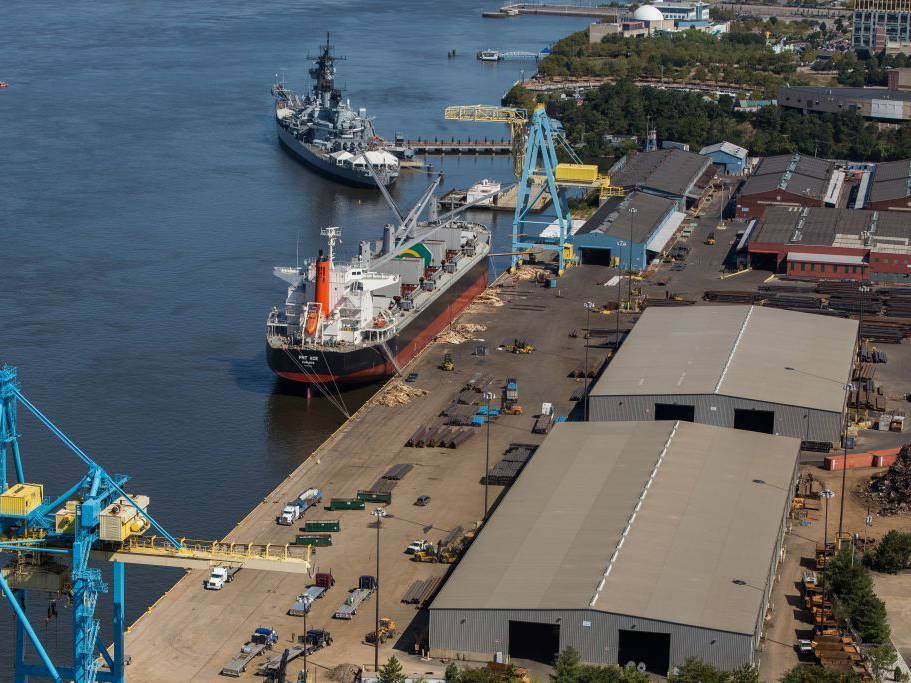Steel, lumber continue as major cargoes, offshore wind continues despite setback.

The offshore wind industry in New Jersey took a hit last October when Ørsted, the world’s largest offshore wind-farm developer, abandoned two projects in waters off the New Jersey shore. The company’s statement on its action blamed “high inflation, rising interest rates, and supply-chain bottlenecks,” all which are also motivating Ørsted to review other U.S. wind projects.
The State of New Jersey is investing hundreds of millions of dollars to develop a wind port near the mouth of Delaware River. The South Jersey Port Corporation, for its part, has facilitated the development of a monopile manufacturing facility at its port in Paulsboro and has plans to redevelop the port of Salem, near the wind port, as a secondary manufacturing hub for offshore wind components.
Dugan is referring to the Atlantic Shores project, planned for a lease site near Atlantic City, and sponsored by Shell and EDF Renewables, a French company. “The current schedule calls for installation starting in 2027 and becoming operational in 2028,” he said. “The project will involve 110 turbines in Phase One of the lease area.”
That’s why Dugan “anticipates there will definitely still be a market for the monopile manufacturing that’s been set up in Paulsboro,” an operation that is up and running. “We are now just waiting for the user to be confirmed,” said Dugan.
Upriver from Paulsboro, at the Balzano Terminal in Camden, a rail improvement project is ongoing which is replacing all the on-terminal rail infrastructure. “That project should be completed in May,” said Dugan. “It’s important because, especially during the winter steel season, a good proportion of the steel cargo is loaded on rail.”
Another project ongoing in Camden involves the replacement of roofs on cargo sheds. “A fair amount of the cargo that’s unloaded needs to be stored indoors,” said Dugan, “especially steel coils that need to be protected from the elements.” The SJPC is also replacing the fire suppression system at its Broadway terminal, where most of the plywood and lumber that comes into the port is initially stored.
Breakbulk Mainstays
Steel and forest products continue as the mainstays of South Jersey’s breakbulk business. The winter steel season, which stretches from early December through March, is now ongoing. Deliveries of steel coils, and other steel products, destined largely for automotive plants around the Great Lakes, surge during the months when the Saint Lawrence Seaway is closed.
Most of the steel handled at the port comes from Europe, primarily the Netherlands and Germany, and to a lesser extent Belgium and France. The primary carrier for winter steel is Clipper Bulk, based in Antwerp, which runs a liner service between Antwerp and Camden. “A few of our customers also charter vessels directly from plants into Camden,” said Dugan.
“February to early March is the peak,” he added. “So far, this year looks as strong as the last winter steel season,” when the port handled around 1.1 million metric tons of steel, about 1.5 percent more than in 2022.
On the forest products front, plywood shipments from Southeast Asia, which were traditionally the primary source of that product delivered to Camden, ground to a halt in recent years because the market was over-saturated with inventory and because container rates dropped drastically, leading many plywood shippers to opt for containers.
“Now that the container rates have increased dramatically,” said Dugan, “we’re going to see more plywood from Southeast Asia come back into Camden. We have a couple of plywood ships scheduled for early this year and we’re getting several inquiries. Camden has traditionally been a distribution center for breakbulk commodities and we’re expecting that to pick up.” The South Korean Pan Ocean and Swire Bulk, based in Singapore, are the primary carriers delivering plywood to Camden.
Last fall, the port of Camden started handling lumber imports from Brazil, primarily fencing, on vessels of the Norwegian carrier G2 Ocean, which is distributed to home improvement outlets. “We’ve had four or five of those shipments,” said Dugan, “and so far, they seem pleased with our services, so we expect that to continue.”
The port also has a new salt import customer from Chile which is leasing three acres in Camden, where bulk salt is unloaded and prepared for distribution. “Around 16,000 metric tons of bulk salt came in last year,” said Dugan. “They bag it and palletize it and ship it out by truck to home improvement centers around the region.”
The port’s biggest export commodity is scrap metal, which is running somewhat slower than usual in recent months. Dugan attributes that to “the slowing of the Chinese economy.”
New Handling Equipment
The SJPC is in the process of taking delivery of electric cargo handling equipment, for an eventual total of 27 pieces, including forklifts of different sizes and electric rail car movers. “We’re about two-thirds of the way through that project,” said Dugan. “When we take full delivery, we’ll start to phase out the older diesel equipment.” The delivery of the full fleet of electric equipment is scheduled to be completed in the third quarter of 2024.
The SJPC is also undergoing a master planning exercise which is expected to be completed this year. “We’re going to be looking at some short term, medium term, and long-term goals for the port of Camden,” said Dugan. “The idea is to create more terminal capacity for handling and storing cargo both indoors and outdoors as well as some reconfigurations of terminal access and egress for better truck circulation.
“We expect that plan to be completed this year,” he added, “and then we’ll start taking action on the shorter-term goals. That should see additional warehousing capacity and open storage capacity being developed at the two Camden terminals.”




